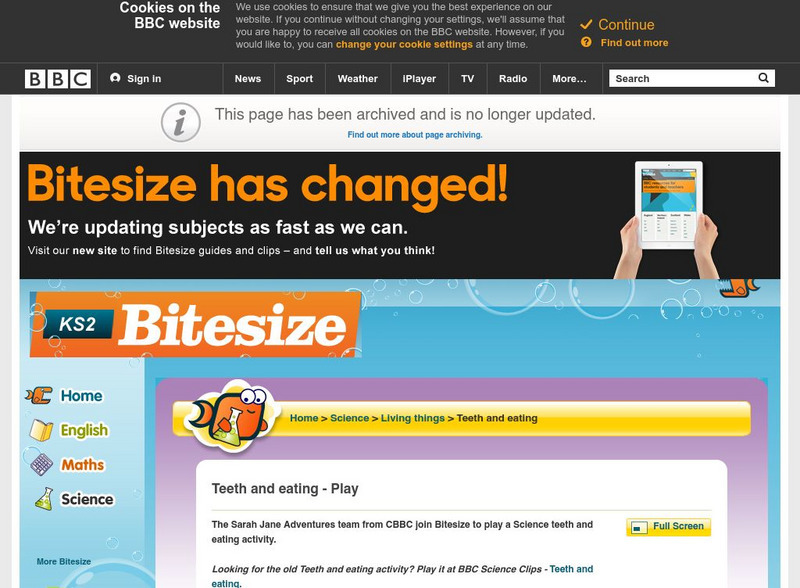Hi, what do you want to do?
Curated OER
Martian Mummies
Students participate in "Raiders of the Future", a role play about futuristic scientists sending a spaceship to Mars for research and exploration. They collect geological samples for analysis, discover the ruins of an ancient...
Curated OER
It's All In The Rocks
Students think critically to determine fact or inference when examining sedimentary layers with embedded fossils. Geology and evolutionary biology are introduced. They individually write a story about various diagrams and share their...
Curated OER
Potato Fish Adaptations
Students examine fish adaptations. They identify types of adaptations, and create a 3-D model of an imaginary fish that demonstrates various adaptations using a potato and craft materials.
Curated OER
WHY WE AREN'T FILTER FEEDERS
Students describe three methods of obtaining food: scavenging, filter feeding, and hunting. They describe three methods of obtaining food: scavenging, filter feeding, hunting, and list at least two reasons why humans are not considered...
Curated OER
Coloration
Learners conduct an experiment picking out colored vs. camoflauged toothpicks out of the grass. They list and describe different types of coloration and explain how coloration assists the great horned owl and the striped skunk survive.
Curated OER
Water Quality
Students investigate the water cycle and evaporation. They study the porosity and permeability of groundwater, and the capillary action in soil in this unit.
Curated OER
Cleanliness
Students identify ways that staying clean contribute to good health. They perform an experiment involving potatoes and washed and unwashed hands, observing the results. They complete a cleanliness chart, checking off each healthful habit...
Curated OER
Survival Features
Third graders identify features of producers, herbivores and carnivores. They discuss the features that aid in survival for those animals. They organize animals into categories to complete the instructional activity.
Curated OER
Clean Water and World Water Day
Students investigate World Water Day in relation to clean water that should be used responsibly. They create lists of ten things they use water for and compare their answers in small groups. They research a documentary for World Water...
Curated OER
What Does Your "Homunculus" Look Like?
Students determine the density of touch receptors in various parts of the body on the right hand side. They use collected data to draw a picture of the
"homunculus" of an experimental subject.
Curated OER
Earth and Seasons
Sixth graders comprehend that the path Earth takes as it revolves around the sun is called its orbit. They also comprehend that the axis is an imaginary line that passes through Earth's center and its North and South Poles. Students...
Curated OER
Croc Talk
Students investigate and study about the members of the crocodilian family and then create poster presentations and write poetic odes to them. They distinguish between facts and myths about crocodilians and assess the new discoveries...
Curated OER
Learning Bird Traits
Young scholars draw and label a bird. In this bird traits lesson, students learn what traits make a bird different from other animals. Young scholars are taught how to draw a bird and are expected to label the various body parts they drew.
Curated OER
Spring, Summer, Fall, Winter
In this seasons worksheet, students cut out the picture cards at the bottom of the page, sort the pictures and paste them with the matching season.
Curated OER
Fossils: Clues to Ancient Life
You can make your students amateur paleontologists with great fossil lesson plans.
Curated OER
Stay Well Cards
Students use ice-cube brushes to paint pictures demonstrating ways that they can stay healthy.
Curated OER
Holey Clamshells
Pupils analyze data to make hypotheses and conclusions regarding the predator/prey relationship between moon snail and surf clams.
Curated OER
Theatre Lesson Plan: Finding Your Way
Second graders identify story elements in familiar stories from their lives. In this story elements lesson, 2nd graders act out familiar activities by following directions. Students read a story and discuss the story elements....
Curated OER
CSI Clamshell Investigation
Students explore predator/prey relationships. They research information on moon snails and claims. Students draw conclusions from the data collected. They use math and graphing to determine if there is a relationship to the clam's size...
BBC
Bbc Schools: Ks2 Bitesize: Science: Living Things: Teeth and Eating
An interactive teeth and eating exercise followed by some research information on teeth. A quick quiz to check for understanding follows the activity.
Channel 4 Learning
4 L: Science Essentials: Choose Life
A great review for understanding life cycles and many aspects of living things. Find topics and their main ideas, vocabulary review, quizzes, and complementary activities for teachers to use.
BBC
Bbc Schools: Ks2 Bitesize: Science: Teeth and Eating
A review of key concepts about teeth and their development, with diagrams, activities, and quiz questions.
University of Manchester
Children's University of Manchester: Teeth and Eating: Types of Teeth
There are many different types of teeth in your mouth. Learn about incisors, canines, premolars, molars, and wisdom teeth as well as the difference between your primary (or baby) teeth and your permanent teeth.




























